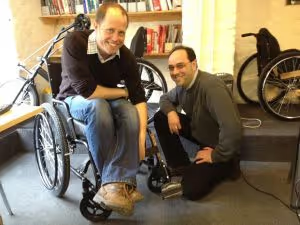Testing Times

Over the last month, we have been concentrating on testing the emergency wheelchair design to make sure it is strong enough and performs well. There are a number of ways to ensure wheelchairs are fit for purpose. WHO have guidelines which show how wheelchair designs and service provision should meet the needs of wheelchair users in less resourced settings. We use these to help inform the design process.

Wheelchair designers Chris and Stefan with the emergency wheelchair prototype
International standards (ISO) also exist and we use these to help ensure our wheelchairs are strong and durable. We sent one wheelchair to an independent ISO certified testing centre in China to undergo a range of tests that simulate impacts and long term use, showing physical weaknesses where a wheelchair might fail. From this test we have identified that the castor barrel area will need strengthening. Once we have made changes to the design, the tests will be repeated. These tests are performed initially at the factory producing the prototypes and then at the independent testing facility until the wheelchair passes all the necessary parts of the test.
We are also preparing for wheelchair user trials which will give an initial indication on how this wheelchair design will perform during day to day use. This type of testing is subjective, but helps to show up any issues with the way wheelchair users interact with the wheelchair.
Our partner in this programme, Handicap International, has chosen to run the trials in Pakistan – a region that has sadly been subjected to a number of emergencies in recent years. Handicap International has been working in Pakistan for 20 years, initially supporting Afghan refugees and subsequently forming part of the emergency response to the 2007 earthquake. Since then they have been involved in reconstruction, organising aid to people affected by flooding and assisting people caught up in the fighting between the Pakistani army and the Taliban.
Five wheelchairs have been shipped from the factory in China to Pakistan for trialling over a three month period. The wheelchair users who will be trialling these wheelchairs have to be carefully chosen to ensure they are healthy and able to give useful feedback. The triallers will be experienced wheelchair users who have stronger opinions about how a wheelchair should perform. However, in an emergency, the majority of people who will receive these wheelchairs won’t have used a wheelchair before.
We’ve developed a package of documents for the trials with user briefing and agreements, so we can be sure triallers are participating knowledgeably and willingly. Clinical staff will have questionnaires to guide them as they follow up the triallers.
It’s always exciting and daunting when you get to the trial stage. We’re hoping over the next couple of months we’ll get some really good feedback which will help fine-tune the emergency wheelchair design and take us one step closer to having these chairs in production.
Sarah Sheldon - Programme Coordinator, Motivation
Stay updated
Sign up for our newsletter to receive regular updates on resources, news, and insights like this. Don’t miss out on important information that can help you stay informed and engaged.
Related articles
.png)


Explore Elrha
Learn more about our mission, the organisations we support, and the resources we provide to drive research and innovation in humanitarian response.